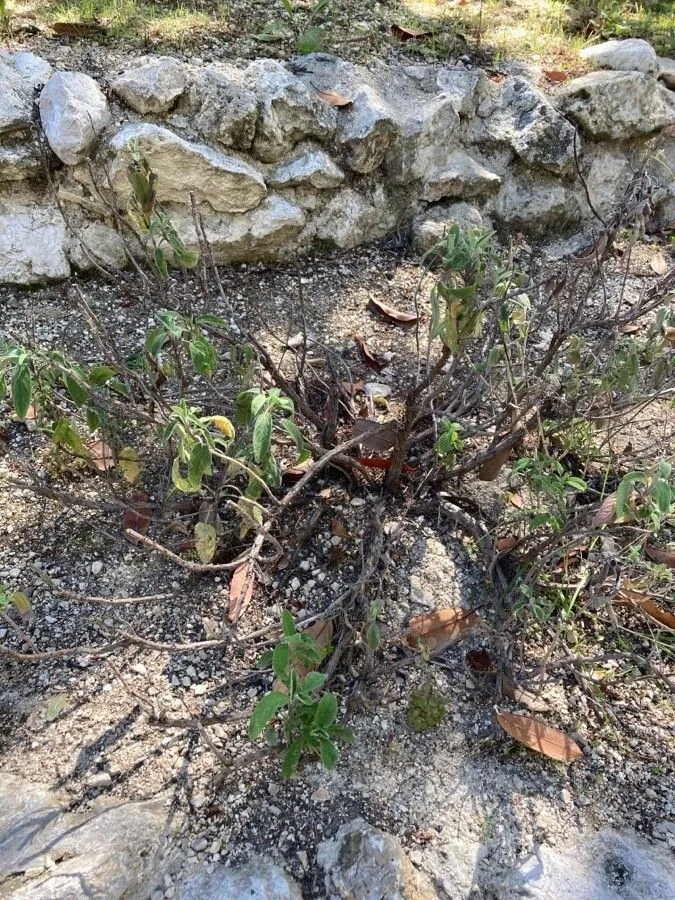
Author: Mill.
Bibliography: Gard. Dict. ed. 8: n.º 5 (1768)
Year: 1768
Status: accepted
Rank: species
Genus: Salvia
Vegetable: False
Observations: C. & E. Medit
Greek sage, scientifically known as Salvia fruticosa, is a perennial shrub belonging to the Lamiaceae family. Originating from the Mediterranean region, it flourishes in both Central and Eastern areas, adapting well to the dry, rocky soils typical of these climates. The plant, also known as East Mediterranean sage, holds a notable historical presence with its description first appearing in Gardner’s Dictionary’s 8th edition in 1768, as classified by the botanist Philip Miller.
Greek sage is revered for its robust and aromatic leaves, characterized by their woolly, gray-green texture, which release a potent fragrance when crushed. The shrub typically grows to a height of 1 to 1.5 meters, showcasing whorls of pale blue to violet flowers during its blooming season, usually from late spring to early summer. These blossoms not only add aesthetic value but are also frequented by pollinators such as bees, butterflies, and hummingbirds, enhancing the biodiversity of its native habitat.
Culturally and historically, Greek sage has been utilized for various purposes. In folk medicine, it is praised for its potential anti-inflammatory and antioxidant properties, often brewed into teas or used in herbal remedies. It is also a culinary staple in Mediterranean cuisine, where its pungent, slightly peppery flavor enhances an array of dishes, from meats to stews.
Cultivating Salvia fruticosa is relatively straightforward, given its preference for full sun and well-drained soil. It is drought-tolerant, making it an excellent choice for xeriscaping and low-water gardens. Regular pruning can help maintain its shape and encourage new growth, ensuring a lush, leafy display year after year.
In summary, Greek sage is not just a plant of ornamental and sensory delight but also a valuable herb with deep roots in Mediterranean tradition and folklore. Its resilience and multifunctional uses make it a cherished addition to both gardens and natural landscapes, continuing to thrive and inspire through the ages.
Eng: greek oregano, greek sage, greek-oregano, salvia de jardín, three-lobe sage
Fra: sauge de grèce, sauge ligneuse, sauge à trois lobes
Swe: busksalvia
Deu: griechischer salbei
Spa: salvia de jardín
En: Greek sage, Greek-oregano, Three-lobe sage, Greek oregano, Salvia de jardín, Three-leaved Sage, Three-lobed Sage
Ar: مريمية يونانية
Fr: Sauge à trois lobes, Sauge de Grèce, Sauge ligneuse
De: Griechischer Salbei
He: מרווה משולשת
Es: Salvia de jardín
Sv: Busksalvia
Taken Dec 28, 2019 by Francisco Caba (cc-by-sa)
Taken Nov 16, 2021 by junwen zheng (cc-by-sa)
Taken Jan 3, 2020 by fernandez garcia del rincon luis (cc-by-sa)
Taken Nov 26, 2020 by Daskalantonakis Manolis (cc-by-sa)
Taken May 17, 2022 by ahmad abualrob (cc-by-sa)
Taken Dec 29, 2019 by Almudena Jiménez (cc-by-sa)
Taken Apr 21, 2014 by Tela Botanica − Liliane Roubaudi (cc-by-sa)
Taken Apr 8, 2022 by Parc Stanislas Nice (cc-by-sa)
Taken May 3, 2020 by agal (cc-by-sa)
Taken Mar 9, 2020 by Diana (cc-by-sa)
Taken May 3, 2020 by agal (cc-by-sa)
Taken May 13, 2022 by Marco Rizzo (cc-by-sa)
Taken Apr 17, 2020 by Xeve Dor (cc-by-sa)
Taken Jun 3, 2022 by pasquale pianese (cc-by-sa)
Taken May 4, 2020 by pacocap (cc-by-sa)
Taken Aug 9, 2019 by Werner Rom (cc-by-sa)
Taken Sep 9, 2022 by Werner Rom (cc-by-sa)
Taken Oct 2, 2021 by Lutz Levente (cc-by-sa)
Taken Sep 17, 2019 by Z Z (cc-by-sa)
Taken Jan 10, 2021 by Laville Laville Logan (cc-by-sa)
Taken Oct 29, 2020 by Esin Bozdogangil (cc-by-sa)
Taken Feb 10, 2022 by Cristian Stoleriu (cc-by-sa)
Taken Jan 9, 2020 by Cambria Mateo Santino (cc-by-sa)
Taken Oct 15, 2018 by Photoflora – Benoit BOCK (©)
Taken May 10, 2022 by Mar (cc-by-sa)
Taken Apr 30, 2013 by Tela Botanica − Liliane Roubaudi (cc-by-sa)
Taken Apr 30, 2013 by Tela Botanica − Liliane Roubaudi (cc-by-sa)
Taken Apr 30, 2013 by Tela Botanica − Liliane Roubaudi (cc-by-sa)
Taken Apr 30, 2013 by Tela Botanica − Liliane Roubaudi (cc-by-sa)
© copyright of the Board of Trustees of the Royal Botanic Gardens, Kew.
© copyright of the Board of Trustees of the Royal Botanic Gardens, Kew.
© copyright of the Board of Trustees of the Royal Botanic Gardens, Kew.
Family: Myrtaceae Author: (F.Muell.) K.D.Hill & L.A.S.Johnson Bibliography: Telopea 6: 402 (1995) Year: 1995 Status:…
Family: Rubiaceae Author: Pierre ex A.Froehner Bibliography: Notizbl. Bot. Gart. Berlin-Dahlem 1: 237 (1897) Year:…
Family: Sapindaceae Author: Koidz. Bibliography: J. Coll. Sci. Imp. Univ. Tokyo 32(1): 38 (1911) Year:…
Family: Asteraceae Author: A.Gray Bibliography: Pacif. Railr. Rep.: 107 (1857) Year: 1857 Status: accepted Rank:…
Family: Fabaceae Author: Medik. Bibliography: Vorles. Churpfälz. Phys.-Ökon. Ges. 2: 398 (1787) Year: 1787 Status:…
Family: Aspleniaceae Author: (Cav.) Alston Bibliography: Bull. Misc. Inform. Kew 1932: 309 (1932) Year: 1932…